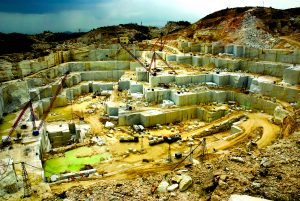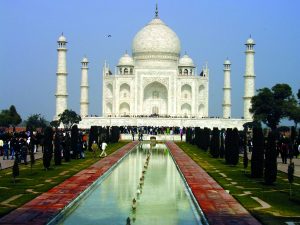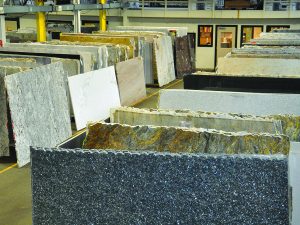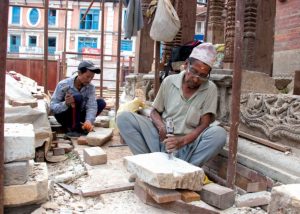 When we think of Taj Mahal, we think of love and also Makrana marble- the white marble with which eternal structure of love has been created. In fact, Makrana marble is used for sculptures and as a décor for buildings. Little doubt it has been used for iconic monuments like the Taj Mahal in Agra, Victoria Memorial in Kolkata and Rashtrapati Bhawan in Delhi. Now the Makrana Marble is listed as a Global Heritage Stone by International Union of Geological Sciences.
When we think of Taj Mahal, we think of love and also Makrana marble- the white marble with which eternal structure of love has been created. In fact, Makrana marble is used for sculptures and as a décor for buildings. Little doubt it has been used for iconic monuments like the Taj Mahal in Agra, Victoria Memorial in Kolkata and Rashtrapati Bhawan in Delhi. Now the Makrana Marble is listed as a Global Heritage Stone by International Union of Geological Sciences.
 However, though the marble industry provides employment to thousands of people, and contributes substantially to the economy of the state, no attempts have been made to evaluate and table the social and environmental costs of marble mining. The death of the Gomati is just one example of how mammoth the ecological cost can be. It has come about through careless and unplanned marble mining in the river’s catchment and the blocking of rivulets through the dumping of marble overburden and slurry. The river has been reduced to a narrow, seasonal stream that comes alive only during the monsoon.
However, though the marble industry provides employment to thousands of people, and contributes substantially to the economy of the state, no attempts have been made to evaluate and table the social and environmental costs of marble mining. The death of the Gomati is just one example of how mammoth the ecological cost can be. It has come about through careless and unplanned marble mining in the river’s catchment and the blocking of rivulets through the dumping of marble overburden and slurry. The river has been reduced to a narrow, seasonal stream that comes alive only during the monsoon.
Taking note of the situation, and prompted by a PIL by a local NGO and other environmental organizations, the Supreme Court ordered a complete ban on marble mining in 2002, over the whole of Rajasthan. The ban did not last long; lobbying and affidavits by the state government, lobbying by the media for development activity, fear of unemployment, and changes in policy and permission regimes all ensured that it was lifted a mere two months later.
Last year, the Rajasthan High Court ordered the closure of 474 marble mines in Makrana that were found to be flouting the rules with impunity. No action has been taken on mines in the southern part of Rajasthan whose owners are in a hurry to extract as much as they can before the court wakes up or the department realizes that the time to take appropriate action has come.
Desertification
Bhomik Shah who worked with WWF-India as senior programme coordinator and Aakash Mehrotra, a researcher in a paper titled “Mountains of Marble Waste” observed that there increasing threat of desertification. The situation is so bad that in many parts there is no pastureland for cattle to graze and no productive farmland to plough. The tribals of Obri village in Udaipur district, for example, now have no common pastures left for their cattle or farmland to grow food. The entire area is an intense marble mining zone. Fifty-five-year-old Hukma Bhai from Obri says: “Tees saal pahle hamne mines ka swagat kiya lekin ab hum apne jungle or zamin sab kho chuke he. Jo kuchh bacha he wo kisi kam ka nahi he.” (“Thirty years ago we welcomed the mines but now we have lost our forests and our land. Whatever is left is useless.”
Water table
The limestone mines of Chittor have breached the region’s water table. The mines have been operational since 1987, and the unit has excavated pits as much as 40 metres deep. In New Surjana village, located near the mines, there is acute water scarcity and recession in the groundwater table. Residents claim that water could earlier be found at 25 feet, but now the water table has fallen to as low as 400-500 feet.
Unregulated legal mining and rampant illegal mining in Rajasthan has systematically destroyed forests, devastated the Aravallis, and played havoc with the water resources of the state, says Centre for Science and Environment’s Sixth State of India’s Environment report, “Rich Lands, Poor People” — Is sustainable mining possible? With the industry pouncing on mining leases in schedule V areas – banned for the last nine years and opened by the previous Vasundhara Raje Scindia government in 2008 — it could be only a matter of time before the damage to ecology and environment becomes irreparable.
Rajasthan has the highest number of mine leases in the country — 1,324 leases for major minerals, 10,851 for minor minerals and 19,251 quarry licenses for mining stones. The state earned about 590 crore royalty from major minerals like lead, zinc and limestone in 2004-2005. But the sector contributes only three per cent to the state’s revenue. Rajasthan holds reserves for 44 major and 22 minor minerals and is the only producer of garnet, jasper, selenite, wollastonite and zinc concentrates. It is also the leading producer of calcite, lead concentrate, ball clay, fireclay, ochre, phosphorite, silver and steatite. But it is best known for its production of marble, sandstone, marble and other stones. It produces 10 per cent of the world’s and 70 per cent of India’s output of sandstone. Ajmer, Bhilwara, Bikaner, Dungarpur, Jaipur, Pali, Rajsamand, and Udaipur are its main mining districts.
Rising deaths
Rajasthan has thousands of unorganized mines, which can be as small as one-twentieth of a hectare. They fall out of the purview of government control and there are no accounts of these mines. Illegal mines have no mechanism in place to implement environmental protection measures. For instance, sandstone quarries may be as small as 200 x 100 feet and because these mines operate beyond the law, workers’ rights are not recognized. Basic facilities such as toilets and water do not exist, nor do safety procedures or compensation for accidents. In Makrana mines, there is an average of one death a day from work-related illnesses like silicosis and tuberculosis.
It is the large variety of marbles that make if attractive for some unscrupulous segments to exploit. Rajnagar, is considered to be the largest marble-producing region in the world. Located near Udaipur, Rajnagar is home to over 2,000 marble units. Although the original colour of marble is white, but to make these commercially viable, a chemical process is adopted. Marble rocks in this region are passed through a technical process of color change. Indo-Italian is a unique variety prepared by a similar process. Its color is pistil. It is here the problem arises. This process pollutes the environment. Therefore, by the order of the Supreme Court, many units adjacent to the Sariska Tiger Sanctuary have been closed.
A distinct marble is prepared by giving it a slightly darker and pinker color. It is known as Onyx marble, which is a different and exotic stone, which gives a beautiful and breathtaking impression. It gives royal and stunning appearance when it is used in flooring and other interior designing projects. There are so many excellent uses of onyx marble. Onyx is available in beautiful different color. Onyx marble is known for its rich palette of beautiful colors and appearance. It became a popular choice due to its beauty and elegance. It is easy to use also it is a versatile material that is used to make wall claddings, tabletops, wainscot, and vanity tops. It is similar to Pakistan Onyx marble gemstone.
Makrana is the source of the marble used in the Taj Mahal. It is situated at a distance of 60 km from Kishangarh and falls in the Nagaur district of Rajasthan. The region has various mining ranges, mainly Doongri, Devi, Ulodi, Saabwali, Gulabi, Kumari, Neharkhan, Matabhar, Matabhar kumari, Chuck doongri, Chosira and Pahar Kua amongst others. World’s largest marble-producing area, with over 2,000 gang saw units located in the nearby town of Udaipur to process the material produced. Agaria is the best variety of this area, with numerous other varieties and patterns, primarily in white base. The marble is dolomite and often has quartz intrusions.
Located near the capital city of the state of Jaipur (also known as the ‘Pink City’), it is dolomite marble with intrusions of tremolite, and is commonly known by the name of pista (pistachio) marble, because of the green colored tremolite against an off-white background. One of the famous varieties of this area was known as Indo-Italian, owing to its resemblance with Satvario Marble. The Supreme Court of India because of the vicinity of the area to the Sariska Tiger Reserve now bans most of the mining of this famous field. Also known as Onyx Marble, it has thick bands of green and pink hint. A resemblance to Onyx Marble from Pakistan gives it this name. This is also highly dolomite. It is considered to be a thick layer stone with a green and pink aura.
Though it has not been metamorphosed and hence is still a limestone, it is known as Yellow Marble in trade circles. It is mined in the Jaisalmer District. The yellow marble is called Jaisalmeri marble in commercial areas. Marble found in Abu is basically used in decoration. This stone is mostly used in sculpting temples and sculpture. The stone, known as Green Marble, is found in the mines of Kesariyaji region near Udaipur. However, Kishangarh in Marwar is famous as Marble Mandi. The there is yellow marble. These are ultra basic rocks in shades of brown and green color. The crisscross linear pattern given it a remarkable resemblance to a photograph of dense forest. These are also known as forest green/brown or fancy green/brown. There is Kishangarh Marble. Sand stone marble is equally indispensable in the marble industry. Sand stones available in different sizes and types are mostly transparent. In addition to a mixture of metal particles, it also occurs in the form of fractures or fragments. Sand stone is also available in brown, green, pink, white and black and white colors.
Sand stones of certain colors are available only in certain areas. However, they are also made from a mixture of water or other chemicals. They have immense ability to absorb water. They are most commonly used for filling or bridging cracks. Sand stones are basically deep shining. They also have the form of chalk and coal. Its maximum use is in framework during construction. Sand stone is the backbone for the handicrafts industry.
Sand stone quarries
Although there are sand stone mines in Bihar, Gujarat and Assam and Andhra Pradesh, 90 percent of sand stone is extracted from the mines of Bundi, Chittor, Kota, Dholpur, Jodhpur and Sawai Madhopur in Rajasthan. Sand stones also exported. Architects say that sand stone of various colours found in these areas are considered superior in terms of interiors and exteriors. Talking about its selection of attractive colors, Agra Red, Jodhpur Red, Lalitpur Pink, Rainbow Sandstone and Raj Green are considered more favorites. Architects say that Jodhpur Pink is considered to be the best in terms of exterior decoration. Sand is also found in Rajasthan with about 200 attractive colored hues. Granite is at number five among the products exported from India to overseas.
Growing market
 The way dealers have developed new methods and crafts of the use of marble; its market has also increased proportionally. Surprisingly, despite this, the price is still stable. The demand for it has increased at a rapid pace, and its use in cutting-edge architectural crafts has also increased at the same speed.
The way dealers have developed new methods and crafts of the use of marble; its market has also increased proportionally. Surprisingly, despite this, the price is still stable. The demand for it has increased at a rapid pace, and its use in cutting-edge architectural crafts has also increased at the same speed.
As a result, Rajasthan is setting new heights as the marble-producing region. According to commercial estimates, Rajasthan’s contribution in the country’s marble market is approximately 90 percent. There is a possibility of producing 1 million tonnes in Rajasthan this year. According to a business study, now even the middle class has jumped into the market as a buyer. Probably the major reason for this is the growing shortage of cement and skyrocketing prices.
Gauri Shankar Dhoot, owner of a marble storage unit says that a mixture of marble pieces and white cement is being used in roofing these days. These are called mosaic tiles. The best part is that this mixture is cheaper even than cement. The Sangha units are also trying to make their small blocks.
According to sources in Rajasthan Industrial Development and Investment Corporation, in the last few years, there has been an awakening towards moving towards state of the art. As a result Marble is exploring a new market. Units are now moving rapidly towards making mosaic tiles. However, the most important technological achievement in this direction would be to make a stone plaque rather than a block.
Deepak Bansal, a marble businessman from Makrana says old steel cutters took longer and had a fixed limit. But new and state-of-the-art machines have made this work easier and better. He says that the strength and extent of the machines for carving is not so successful in carving stones. Bansal says that the good thing is that it is indigenous and its price is not more than 10 lakhs.
Problems of traders
However this method also has some disadvantages. It is a very tedious job in a way. The traditional method of mining is the biggest deterrent. Many times it happens that mines freeze and it is not possible to bring them back into position. Most work in mining involves manpower. However, petrol powered cranes are also used up to some point.
The sheer depth of the mines is the biggest obstacle in their excavation. Needless to say difficulties are multiplying. The ban on open licensing process due to foreign exchange regulation some time ago has badly hit people engaged in this business. Apart from this, there has been no provision in the Budget to help businessmen by way of the excise duty per square meter. Of course, it has been reduced from 20 to 10. But traders said that the problems remained the same; because a rebate of 10 was given with the condition that the wastage should not be more than 25 per cent. As marble cutting does not have this state of dissipation, the officials find this as a handle to harass the traders.
Despite problems, the mood of the industry is still upbeat. It is also because demand is increasing day by day. There is no unnecessary bounce. Particularly, the future of Makrana bright future is increasing. There is no doubt that this grout came from the basic and traditional parts of the market.
If seen from the perspective of employment, consumption and the possibility of growth, then inconsistent changes can also be tolerated.
However, the way GST was introduced, it has hurt this market. The marble industry was flourishing well before demonetization and GST were introduced; but now everything has gone awry. Declining sales, long hours of work and drowning are swallowing the glow of the marble are the new norms.
A report of mining department observes that employment level in this industry has come down from 30% to 12%. The entrepreneurs say that demonetization GST and RERA have had the worst impact on the industry. Sources in the industry department also agree that if the demonetization and GST are the biggest reason for the downtrend and marble industry is its biggest example.
Sources say what is the point of increasing the tax rate from five percent to 28 percent? They allege that the GST has completely swallowed demand and consumption.
If there is a silver lining in these worsening conditions it is because the US market signal a recovery. The demand in the Middle East is also encouraging. The demand for this sector in the commercial market too can be said to be somewhat encouraging.
The black world
The gleaming marble is undoubtedly enthralled by its silver hues, but the industry has a slew of exasperating truths that make its whitewash look patchy. Marble exports from Rajasthan are to many countries including Spain, Italy, Turkey and Vietnam. However, there is a competition in domestic market because of availability of global brands in India. The global brand of marble is creating a fierce competition in the market. Due to liberalization, there was a provision in the last decade during the UPA government to give import licenses to businessmen on the basis of the prescribed regulations for importing foreign marble. But this
facility created a black world in the marble market.
Truth of import license
The issuance of import licenses led to breeding of corruption. There was scramble to get import license. One can only make a guess as to how many political leaders plunged into this pool of corruption.
According to informed sources, during that time, in the Makrana-Udaipur and Ajmer Kishangarh Marble Belt alone, Rs one thousand crore black market had flourished. The black market of marble was not limited to this, there was another story of scams. Despite having a defined regulator of import license, its back door was also open. As a result, the payment of additional marble from the back door was paid through ‘hawala’.
For example, if a businessman had a license to import up to three thousand tonnes of imported marble, by just investing Rs 40 lakh rupees, he would have made a profit of four crores by selling it in the open market. This conflagration gave rise to scams on the next day, so new disputes started. As a result, a series of new anomalies began to open. But its biggest loss was seen when there was a hole in the bottom of the revenue of the government. When the Narendra Modi government came at the Center, there was a check at this rampant corruption to some extent. With the abolition of import license the Modi government started a new option of imposing import duty. The sheer amount of import duty is no less surprising. But sources say that there is no dearth of sixes on no balls as well. Make in India also helped checking some malpractices in marble import business and making indigenous manufacturing of marble competitive so that domestic business could strive and thrive. This is the reason that the custom duty on imported products has also been increased considerably. Although the strong lobby of the importers tried in vain to put constraints, but there attempts did not materialize.
Sources say that black marketing of foreign marble may wane but can’t be completely halted. As a result, ‘hawala’ is still in existence while middlemen, who are expert in finding procedural flaws, are seen tainting this system.
Professional experts say that the energy and mining sector is a great example of anomalies. Understanding the geography of marble mining, it is not a task to scrape the foothills of a mountain. The entire land of the marble belt is covered with marble.
Claws of silicosis
 According to Apex Stone Industry Organization Center, Jaipur, Rajasthan is the largest state in the country in terms of production of precious stones. Rajasthan alone provides 5 crore precious stones every year and the annual production of marble is 15 million tonnes. The production of granite and sandstone combined is two and a half million tonnes. There is another issue that is of health of workers. Neither the government nor the businessmen care a fig for that.
According to Apex Stone Industry Organization Center, Jaipur, Rajasthan is the largest state in the country in terms of production of precious stones. Rajasthan alone provides 5 crore precious stones every year and the annual production of marble is 15 million tonnes. The production of granite and sandstone combined is two and a half million tonnes. There is another issue that is of health of workers. Neither the government nor the businessmen care a fig for that.
Shreeji Ka Khera of Bhilwara district alone has lost 70 lives due to silicosis in the last decade. The sinking of stones stuck in the nostrils causes this disease. Even today no solution has been found to check the disease that is fatal and is affecting health of workers in marble industry. According to the World Health Organization, all forms of asbestos cause cancer, with chrysotile asbestos increasing the risk to cancer. This is a major health risk for workers, especially since these illegal mines do not provide safety equipment or compensation in case of accidents or deaths. But who cares?
letters@tehelka.com













